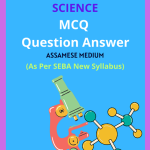Class 7 Science MCQ Chapter 5 Acids, Bases and Salts Solutions in English Medium, Class 7 Science Multiple Choice Question Answer in English to each chapter is provided in the list so that you can easily browse throughout different chapters Class 7 Science MCQ Chapter 5 Acids, Bases and Salts Notes and select need one.
Class 7 Science MCQ Chapter 5 Acids, Bases and Salts
Also, you can read the SCERT book online in these sections Class 7 Science Objective Type Solutions by Expert Teachers as per SCERT (CBSE) Book guidelines. These solutions are part of SCERT All Subject Solutions. Here we have given Assam Class 7 Science MCQs Solutions in English for All Subject, You can practice these here.
Acids, Bases and Salts
Chapter – 5
| MCQ |
1. Which of the following solutions is neutral?
(a) Vinegar.
(b) Lemon juice.
(c) Milk of magnesia.
(d) Sugar solution.
Answer: (d) Sugar solution.
2. Acids:
(a) give substances a sour taste
(b) give substances a bitter taste
(c) give substances a sweet taste
(d) none of the above
Ans: (a) Give substances a sour taste.
3. What taste do acids typically have?
(a) Sweet.
(b) Bitter.
(c) Sour.
(d) Salty.
Ans: (c) Sour.
4. Bases are bitter to taste and are also:
(a) Rough to touch.
(b) Soapy to touch.
(c) Sour in taste.
(d) Used as indicators.
Ans: (b) Soapy to touch.
5. What taste do bases typically have?
(a) Sweet.
(b) Bitter.
(c) Sour.
(d) Salty.
Ans: (b) Bitter.
6. An example of a natural indicator is:
(a) litmus
(b) methyl orange
(c) phenolphthalein
(d) All of the above
Ans: (a) Litmus.
7. What happens to blue litmus paper when it comes into contact with an acid?
(a) It turns red.
(b) It turns green.
(c) It turns yellow.
(d) It remains blue.
Ans: (a) It turns red.
8. Baking soda turns:
(a) Turmeric to red
(b) Purple-cabbage juice to green
(c) Red litmus to blue
(d) All of the above
Ans: (d) All of the above.
9. What do you call substances that show different colours in acidic, basic, and neutral solutions?
(a) Solvents.
(b) Indicators.
(c) Reactants.
(d) Catalysts.
Ans: (b) Indicators.
10. Substances that are produced when acids react with bases are:
(a) salts.
(b) indicators.
(c) litmus.
(d) antacid.
Ans: (a) Salts.
11. What is formed when an acid and a base neutralise each other?
(a) Water.
(b) A gas.
(c) A salt.
(d) A precipitate.
Ans: (c) A salt.
12. Which of the following is not an acid- base indicator?
(a) Litmus.
(b) Methyl orange.
(c) Phenolphthalein.
(d) Sulphur.
Ans: (d) Sulphur.
13. Which substance is used to treat indigestion according to the chapter?
(a) Baking soda.
(b) Lime water.
(c) Milk of magnesia.
(d) Common salt.
Answer: (c) Milk of magnesia.
14. Which of the following is acidic in nature?
(a) lime juice
(b) human blood
(c) lime water
(d) antacid.
Ans: (a) Lime juice.
15. What colour does turmeric turn when it contacts a basic substance?
(a) Red.
(b) Blue.
(c) Yellow.
(d) Green.
Answer: (a) Red.

Hi! my Name is Parimal Roy. I have completed my Bachelor’s degree in Philosophy (B.A.) from Silapathar General College. Currently, I am working as an HR Manager at Dev Library. It is a website that provides study materials for students from Class 3 to 12, including SCERT and NCERT notes. It also offers resources for BA, B.Com, B.Sc, and Computer Science, along with postgraduate notes. Besides study materials, the website has novels, eBooks, health and finance articles, biographies, quotes, and more.



